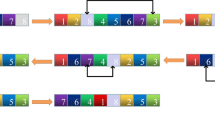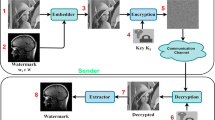Abstract
In reversible data hiding, dual image-based data hiding methods are recently proposed, in which two stego-images are generated after embedding the secret data. In this paper, a new reversible data hiding method is proposed to provide less distortion and integrity of forgery modification in dual stego-images. The modulus function is used to generate four pixel pairs in a sub-block of the cover image. The gap function is used to obtain two pixel pairs from four pixel pairs to maintain less distortion, and the parity bit function is applied to prevent forgery modification attack from the unauthorized party. On the receiver side, the secret data can be extracted and the cover image can be also recovered from the dual stego-images. The experimental results show that the proposed method has strength on embedding capacity and visual image quality.












Similar content being viewed by others
References
Chang CC, Kieu TD, Chou YC (2007) Reversible data hiding scheme using two steganographic images. Proceedings of IEEE Region 10 International Conference (TENCON) pp 1–4
Chang CC, Chou YC, Kieu TD (2009) Information hiding in dual images with reversibility. Proceedings of the 3rd International Conference on Multimedia and Ubiquitous Engineering pp 145–152
Chang CC, Lu TC, Horng G, Huang YH, Hsu YM (2013) A high payload data embedding scheme using dual stego-images with reversibility. Proceedings of the 3rd International Conference on Information, Communications and Signal Processing pp 1–5
Cheddad A, Condell J, Curran K, Kevitt PM (2010) Digital image steganography: survey and analysis of current methods. Signal Process 90:727–752
Huang HC, Chang FC (2013) Hierarchy-based reversible data hiding. Expert Syst Appl 40(1):34–43
Huang HC, Chang FC, Fang WC (2011) Reversible data hiding with histogram-based difference expansion for QR code applications. IEEE Trans Consumer Electronics 57(2):779–787
Jana B (2016) High payload reversible data hiding scheme using weighted matrix. Optik 127:3347–3358
Jung KH, Yoo KY (2015) Steganographic method based on interpolation and LSB substitution of digital images. Multimedia Tools and Applications 74(6):2143–2155
Khan A, Siddiqa A, Munib S, Malik SA (2014) A recent survey of reversible watermarking techniques. Inf Sci 279:251–272
Lee CF, Huang YL (2013) Reversible data hiding scheme based on dual stegano-images using orientation combinations. Telecommun Syst 52(4):2237–2247
Lu TC, Tseng CY, Wu JH (2015a) Dual imaging-based reversible hiding technique using LSB matching. Signal Process 108:77–89
Lu TC, Wu JH, Huang CC (2015b) Dual-image-based reversible data hiding method using center folding strategy. Signal Process 115:195–213
Ma YJ, Zhu YS, Liu XY (2016) A novel reversible watermarking scheme for relational databases protection based on histogram shifting. Journal of Information Hiding and Multimedia Signal Processing 7(2):266–276
Nissar A, Mir AH (2010) Classification of steganalysis techniques: a study. Digital Signal Processing 20:1758–1770
Qin C, Chang CC, Hsu TJ (2015) Reversible data hiding scheme based on exploiting modification direction with two steganographic images. Multimedia Tools and Applications 74(15):5861–5872
Subhedar MS, Mankar VH (2014) Current status and key issues in image steganography: a survey. Computer Science Review 13(14):95–113
Wang Z, Bovik AC (2002) A universal image quality index. IEEE Signal Processing Letters 9(3):81–84
Wang Z, Bovik AC, Sheikh HR, Simoncelli EP (2004) Image quality assessment: from error visibility to structural similarity. IEEE Trans Image Process 13(4):600–612
Zhang X, Wang S (2006) Efficient steganographic embedding by exploiting modification direction. IEEE Commun Lett 10:781–783
Acknowledgements
This research was supported by Basic Science Research Program through the National Research Foundation of Korea (NRF) funded by the Ministry of Education (No. 2015R1D1A1A01058019).
Author information
Authors and Affiliations
Corresponding author
Rights and permissions
About this article
Cite this article
Jung, KH. Authenticable reversible data hiding scheme with less distortion in dual stego-images. Multimed Tools Appl 77, 6225–6241 (2018). https://doi.org/10.1007/s11042-017-4533-0
Received:
Revised:
Accepted:
Published:
Issue Date:
DOI: https://doi.org/10.1007/s11042-017-4533-0




